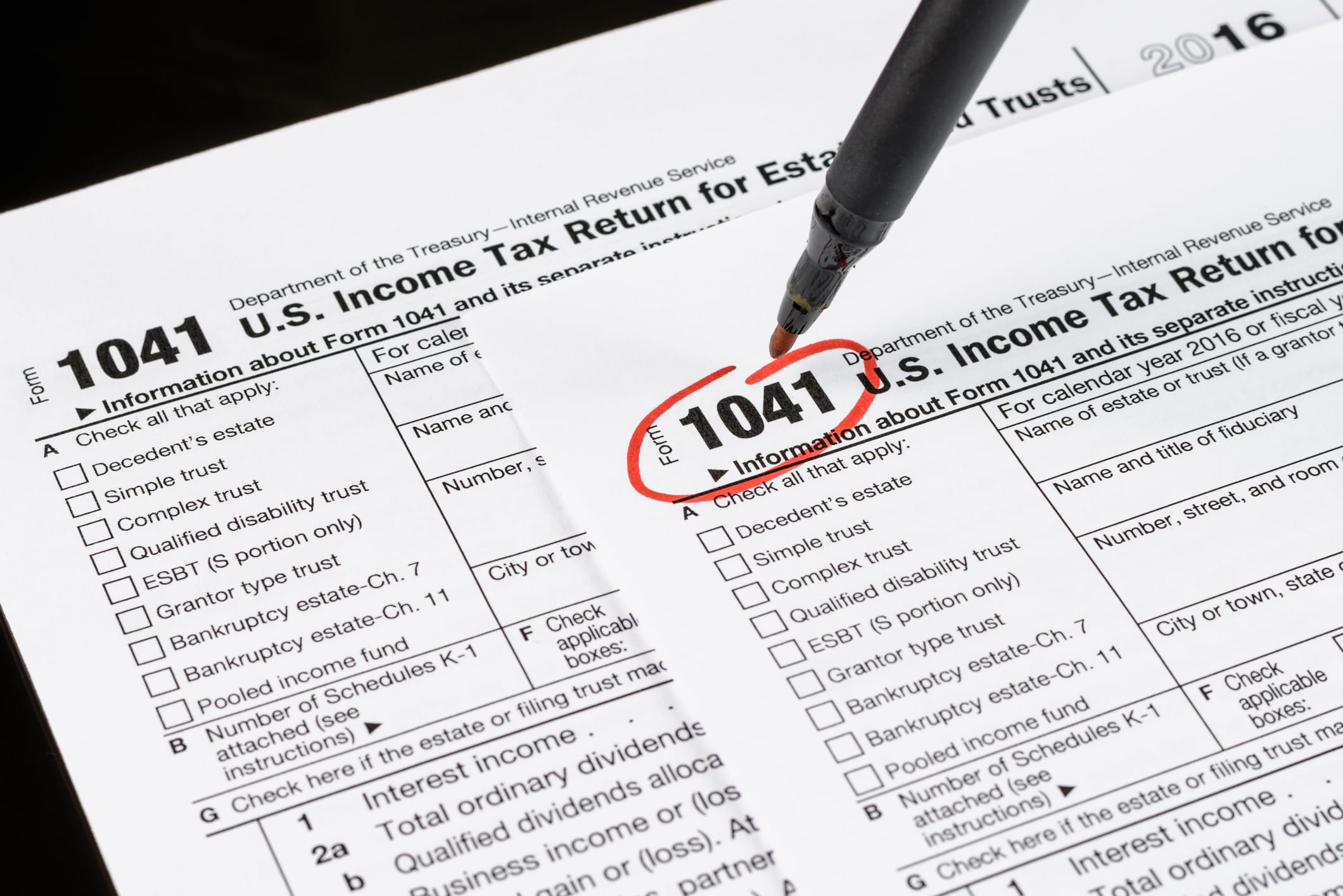
Menu

Playwright Christopher Bullock once wrote that nothing is certain, save death and taxes. Sometimes, the two coincide, leaving behind a somewhat complicated situation. If you are not familiar with tax law, then sorting through its intricacies can be difficult.
In the event of a loved one’s passing, you, or someone close to your loved one must file both their last Form 1040 (an individual income tax report) and a Form 1041 (an estate’s tax report). This is because estates become separate entities after a person passes away. And yet the contents of that estate can (and often do) continue to generate or accumulate money. Which then must be properly taxed.
That's where IRS Form 1041 comes into play. And while it is an income tax report, it is somewhat more complicated and quite different from a Form 1040.
The IRS Form 1041 is the U.S. Income Tax Return for Estates and Trusts, and instructs the fiduciary (trustee, executor, or administrator) of a trust, estate, or bankruptcy estate to file Form 1041 to report the income, gains, losses, and deductions, and various other aspects of said trust or estate.
IRS Form 1041 can either be filed either according to the calendar year or a fiscal year. For calendar year estates and trusts, Form 1041 must be filed by April 15 of the following year. For fiscal year estates and trusts, Form 1041 must be filed by the 15th day of the 4th month following the close of the tax year. You may file for an extension of time to file, using Form 7004.
Not all estates and trusts must file IRS Form 1041. Yet, unlike the name suggests, there are trusts that must file a Form 1041 even if they don’t have any income for the tax year. And there are those that can have some income, yet do not need to file a report. All this can be a little contradictory and confusing. To put it simply, trusts and estates eligible for Form 1041 are:
One more important distinction to make is the difference between income from assets and property already transferred to a beneficiary, and income generated by the trust or estate itself.
Trusts that have already been partially distributed during the tax year can deduct their distributions from their income tax report. Those distributions are then the beneficiary’s responsibility to report. This is important to avoid double taxation.
When a person dies, their date of death is where any and all income is cut off from their name and goes to their estate. This means if a person dies before their last payday, the money they made will be transferred to their estate. It will become subject to a Form 1041 tax return rather than the normal individual income tax return (Form 1040).
However, the decedent must still file a final Form 1040 declaring all of their income for the final tax year that they were alive. This is typically done by the decedent’s surviving spouse, a close relative, or their attorney. There are exceptions to this rule, of course.
For example, a person’s final tax return does not have to be filed if they earned less than $20,000 in their final tax year and died married. These minimums change every year and change from state to state, so it’s important to consult the IRS website and a local tax attorney.
If you are a surviving spouse, simply file a joint return. Being a widow/widower also means you may be eligible for other tax benefits because of your survivor-ship. And if you have a dependent child, you may qualify for a tax break for two years. For more current and state-specific information on how to approach your taxes after the passing of a partner, ask your tax attorney.
For the administrator of an estate or the successor trustee of the trust, you can either file IRS Form 1041 yourself. Or you contact a tax attorney to help you with the process and avoid any errors. It is important to remember that, if some of the trust has already been distributed, you must take note of this in Form 1041 by listing distributions as tax deductible.
This is to avoid double taxation. Any distributions are then the responsibility of the beneficiary. Who then must take note of them in their own income tax return. This deduction is filed in a Schedule B attachment, and called an “income distribution deduction.”
If the estate or trust has no income or a gross income of less than $600 within the tax year, then there is no need to file a return. However, if one of the beneficiaries is a nonresident alien, then a trust or estate must file a tax return (even if it does not have any income).
We have previously mentioned that trusts and estates can take advantage of deductions on any amounts transferred to beneficiaries. However, trusts and estates can also deduct expenses incurred during the probate process or distribution process, including (but not limited to):
In short, for IRS Form 1041, you may deduct any expenses that occurred during the administration of the estate.
Settling a decedent’s final tax affairs is not always a neat and simple process. There are state-specific differences in tax laws, and tax laws are updated and amended constantly, with new tax changes and considerations landing in the laps of taxpayers year after year. It can be a little overwhelming to deal with it all, especially after a loved one’s passing. Furthermore, failure to settle a decedent’s tax affairs properly can incur the wrath of the IRS. Which can be a costly problem. It is wise to consult a legal professional to help navigate your state’s tax laws and figure out the most expedient way to settle all necessary costs.
Founded in 1975 by L. Rob Werner and serving California for over 48 years, our dedicated attorneys are available for clients, friends, and family members to receive the legal help they need and deserve. You can trust in our experience and reputation to help navigate you through your unique legal matters.
Whether you need help creating a living trust or navigating probate, our living trust law firm's compassionate team of estate planning lawyers and probate lawyers are here to help you and ready to answer your questions.
Our goal is to make your case as easy as possible for you. Hiring a lawyer can be a daunting task, but it doesn’t have to be. From the moment you contact our firm, through the final resolution of your case, our goal is to make the process easy and understandable. We cannot change the fact that probate is a long and complicated process, but through our Werner Law Firm Difference, we strive to go out of our way to keep you informed of your case through every step of the way. We are constantly refining our processes and procedures for a more streamlined and calm client experience. Our goal is to have you feel like a burden was lifted from your shoulders, and that we made the whole process an easy one
If you're dealing with a legal matter, we urge you to schedule a free initial appointment today and join the many satisfied clients who have contacted Werner Law Firm.

23 Corporate Plaza Dr., Suite 150
Newport Beach, California 92660
